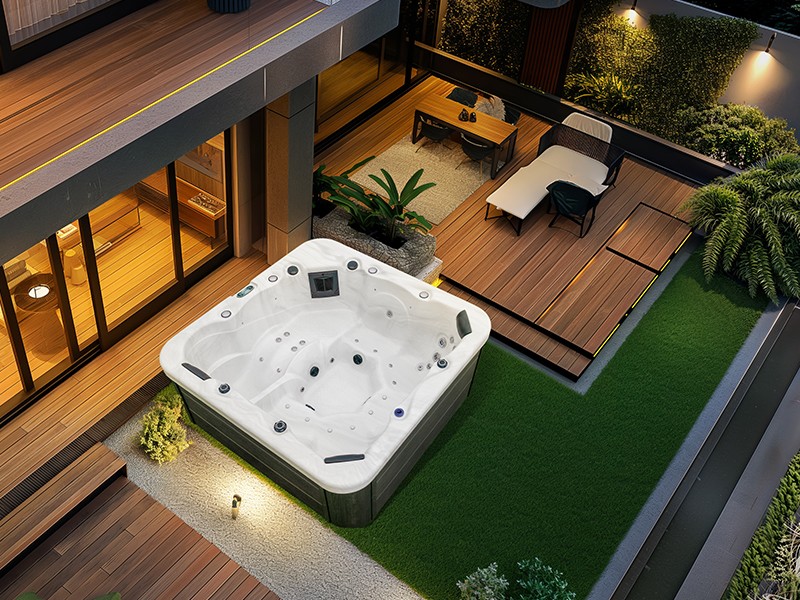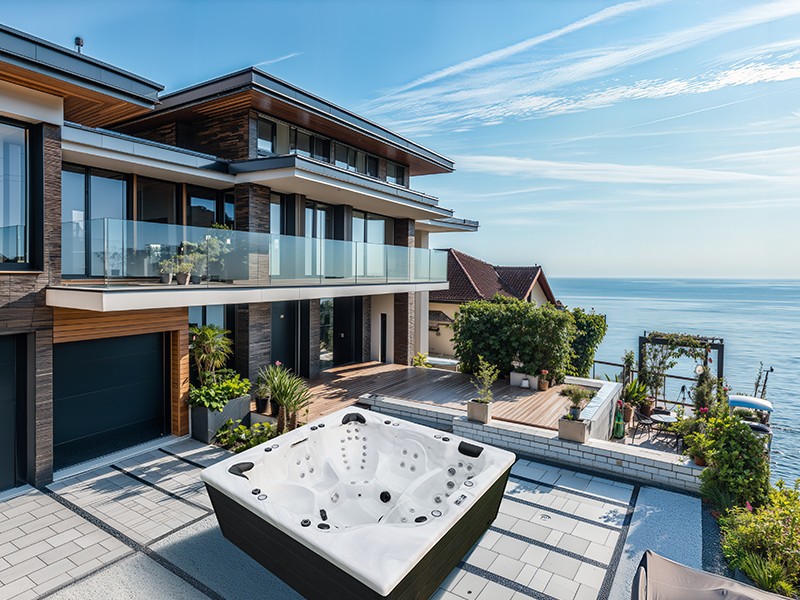
Hot Tub Water Care – Everything You Need to Know
2024-09-16 15:30Owning a hot tub is a luxury that brings great comfort whether it’s a cold winter day or a hot summer day. However, hot tub water care is often overlooked and is key to keeping your equipment running well and your users healthy. With proper water care, you can not only extend the life of your hot bathtub, but also avoid common water problems such as scale, algae growth, irritating odors, and skin or eye discomfort.
This article will start with the basics of water care and detail how to monitor and adjust alkalinity, pH, water hardness, phosphates, and chlorine levels, explain the role of common chemicals, and how to use them appropriately to ensure your hot tub water is always in optimal condition.
What Are the Key Hot Tub Care indicators?
Before we get into the details, it’s important to understand the key hot tub care indicators. These indicators include alkalinity, pH, water hardness, phosphate levels, and disinfectant levels (such as chlorine or bromine). Knowing these indicators will help you effectively control water quality and ensure a safe and comfortable user experience.
● Alkalinity: Alkalinity refers to the amount of carbonates, bicarbonates, and hydroxides in the water. It helps stabilize the pH of the water and prevents wild pH swings.
● pH: pH is a measure of the acidity or alkalinity in water, ranging from 0 to 14, with 7 being neutral. The ideal pH for a hot bathtub should be between 7.2 and 7.8 to ensure user comfort and long-term use of the equipment.
● Water hardness: Water hardness refers to the amount of calcium and magnesium ions in the water. Water hardness that is too high or too low can cause scaling or corrosion issues, affecting the performance and life of the hot tub.
● Phosphate levels: Phosphates are the main nutrient source for algae, and high phosphate levels can cause algae to bloom and affect water quality.
● Disinfectant levels: Chlorine and bromine are the most common hot tub disinfectants used to kill bacteria and viruses. Maintaining proper disinfectant levels is essential to keeping the water clean.
Regularly Use Test Strips to Check Your Tub's Alkalinity, pH, Calcium or Water Hardness, Phosphate and Chlorine Levels
To ensure your hot tub water remains optimal, it is essential to regularly test the water using test strips. Test strips are easy to use and can quickly display the alkalinity, pH, water hardness, phosphate levels and chlorine content in the water.
● How to use: Dip the test strip into the hot tub water for a few seconds, then remove and compare it to the color comparison chart on the packaging. The color change will show the current level of each indicator.
● How often to check: It is recommended to check the water quality at least once a week, especially if the hot bathtub is used frequently. Frequent testing can help you detect and correct water quality problems in time to avoid further deterioration.
Testing and Adjusting Alkalinity
Alkalinity is a key indicator of hot tub water quality, and it plays an important role in stabilizing pH. If the alkalinity is too low, the pH value becomes unstable and easily affected by external factors; if the alkalinity is too high, the water quality may become turbid and the pH value is difficult to adjust. Alkalinity levels should be between 80 and 120 ppm (parts per million). If it's not in that range, you'll have to adjust it. Sodium bicarbonate will raise the alkalinity level; sodium bisulfate will lower it.
● Ideal Range: Hot tub water should be kept between 80 and 120 ppm alkalinity
● Adjustment Methods: If alkalinity is too low, you can increase it by adding sodium bicarbonate (also known as an alkalinity enhancer). If alkalinity is too high, you can lower it by adding a dilute acid (such as dry acid).
● Testing and Maintenance: Regularly testing alkalinity and adjusting based on the test results is fundamental to maintaining stable water quality. It is generally recommended to test once a week and make adjustments when necessary.
Testing and Adjusting pH
A stable pH level is essential to maintaining the quality of your hot bathtub water. A pH level that is too high or too low can cause a range of problems, such as skin and eye irritation, equipment corrosion, and scale accumulation. The pH level describes how acidic or "alkaline" the water is, ranging from 0 to 14, with 7 being neutral. Numbers less than 7 describe acidic substances, while numbers above 7 describe alkaline substances. Chlorine is most effective in destroying bacteria when the pH of a hot tub is maintained between 7.2 and 7.8, which is slightly more alkaline than true neutral.
● Ideal range: The pH of a hot tub should be maintained between 7.2 and 7.8, a range that ensures user comfort and effective protection of the equipment.
● Adjustment method: If the pH is too low, sodium carbonate (pH enhancer) can be added to increase the pH. If the pH is too high, it can be lowered by adding dry or liquid acid (such as hydrochloric acid).
● Testing and maintenance: It is recommended to test the pH weekly, especially if the hot tub is used frequently. Regular pH adjustments can effectively prevent corrosion and scaling problems.
Testing and Adjusting Water Hardness
Water hardness refers to the concentration of calcium and magnesium ions in water. The ideal content of calcium and magnesium in water is between 150 and 250 ppm.
Water hardness that is too high can cause scale to form, while water that is too low can cause the water to become more corrosive, causing damage to the hot tub's heater, pipes, and jets.
● Ideal range: Hot bathtub water hardness should be maintained between 150 and 250 ppm.
● Adjustment method: If the water hardness is too low, it can be increased by adding a calcium enhancer; if the water hardness is too high, it can be reduced by using a softener or by partially changing the water source.
● Testing and maintenance: Test the water hardness once a month and make adjustments as needed to prevent scale accumulation or corrosion problems.
Test and Adjust Phosphate Levels
Phosphates are the main nutrient source for algae, so controlling phosphate levels is an important measure to prevent algae growth. Excessive phosphate levels can cause the water to turn green and cloudy, and increase disinfectant consumption. The ideal level of phosphates should be less than 100 ppb (parts per billion), and when the phosphate ppb level is higher than 300 ppb, it will cause damage to the salt box because the electrodes are coated with calcium phosphate scale, which is difficult to remove.
● Ideal range: The ideal level of phosphates should be less than 100 ppb (parts per billion).
● Adjustment method: If the phosphate level is too high, a phosphate remover can be used to reduce the phosphate concentration. Phosphate removers work by converting phosphates into insoluble substances that are removed by the filtration system.
● Testing and maintenance: It is recommended to test phosphate levels monthly, especially in the spring and summer when algae are more likely to grow.
What Is Free Chlorine in a Hot Tub?
Free chlorine refers to the concentration of active chlorine in a hot tub. It is the main disinfectant in the water and can effectively kill bacteria, viruses and other microorganisms. Maintaining the appropriate level of free chlorine is very important to keep the water clean and safe. The ideal level of free chlorine should be maintained between 3 and 5 ppm.
● Function: Free chlorine can quickly kill pathogens in the water and prevent the growth of bacteria and algae, thereby keeping the water clean.
● Precautions: Too high a free chlorine level may cause skin and eye irritation and even damage the hot bathtub equipment; too low a level cannot effectively disinfect, increasing the risk of water contamination.
How Do I Reduce Free Chlorine in My Hot Tub?
Sometimes, the free chlorine level in a hot tub may be too high and may need to be adjusted to avoid irritation to users or damage to the equipment. Common ways to reduce free chlorine are:
● Natural evaporation: Leave the hot tub lid open and allow the chlorine to evaporate naturally. Exposing the hot bathtub to sunlight can help speed up the chlorine evaporation process.
● Using a neutralizer: You can quickly reduce free chlorine levels by using a chlorine neutralizer, such as sodium thiosulfate. Neutralizers react quickly and neutralize excess chlorine.
● Partial water changes: If chlorine levels are too high and are not easily adjusted, you may consider doing a partial water change to dilute the chlorine content in the water.
What Is the Fastest Way to Reduce Chlorine in a Hot Tub?
If you need to quickly reduce chlorine levels in your hot tub, the most effective way is to use a chlorine neutralizer. Chlorine neutralizers react immediately with free chlorine to reduce the concentration of chlorine, making the water gentler and less irritating to skin and equipment.
● Directions: Follow the package instructions to add the appropriate amount of chlorine neutralizer, which is usually only a small amount to effectively reduce chlorine levels. Test the chlorine level in the water again after use to ensure it is within a safe range.
How Often Should I Add Chlorine to My Hot Tub?
How often you add chlorine depends on how often you use your hot bathtub, the water quality, and weather conditions. Generally, you should add chlorine regularly based on the results of your water quality test to maintain an appropriate level of free chlorine. Regular chlorine addition is key to maintaining water hygiene. It is generally recommended to test chlorine levels every few days and refill as needed.
● Recommended frequency: Add the appropriate amount of chlorine after each use of the hot bathtub, or regularly add it weekly to ensure that the chlorine level is between 3 and 5 ppm. If the water quality test shows that the chlorine level is too low, it needs to be refilled immediately.
How to Reduce the Bromine Level in the Hot Tub?
Bromine is another common hot bathtub disinfectant that has similar functions to chlorine, but is milder and generally does not produce a pungent odor. If the bromine level in the hot tub is too high, it also needs to be adjusted appropriately.
● Natural evaporation: Similar to chlorine, bromine can also reduce its concentration through natural evaporation. Open the lid of the hot tub and use a circulation system to speed up the evaporation process.
● Use a neutralizer: Bromine neutralizers can also be used to quickly reduce the bromine concentration.
● Partial water changes: If natural evaporation and neutralizers are not effective, consider partial water changes to dilute the bromine content.
Can Bleach Be Used in Hot Tubs?
Although bleach contains chlorine, it is not recommended for hot tub disinfection. Household bleach is usually high in concentration and contains other chemicals that may damage hot bathtub equipment and cause unstable water quality. Therefore, it is recommended to use specially designed disinfectants to maintain water quality.
● Recommended use: Always use chlorine or bromine disinfectants designed specifically for hot bathtubs. These products are specially formulated for hot tub water maintenance and are safe to use.
What Does Shocking a Hot Tub Do?
Shock treatment refers to adding a large amount of oxidant, such as chlorine or chlorine-free oxidant, to a hot tub for a short period of time to eliminate organic matter, bacteria and algae in the water. Shock treatment can quickly restore water clarity and increase the effectiveness of disinfectants. It is an important way to maintain water quality.
● Effect: Shock treatment can effectively remove organic pollutants, eliminate odors, remove bacteria and algae, and restore water clarity. It also improves the efficiency of disinfectants to ensure water safety.
● Post-shock testing: After shock treatment, the water quality should be tested again, especially the chlorine or bromine level, to ensure that it is restored to a safe range.
How Often Should I Shock My Hot Tub?
The frequency of shock treatment depends on how often the hot tub is used, the number of people, and the water quality. It is generally recommended to shock treatment once a week to keep the water clean and the disinfectant effective.
● Recommended frequency: If the hot bathtub is used frequently, or the water quality is turbid or odorous, the frequency of shock treatment should be increased. On the contrary, if the frequency of use is low, the shock interval can be appropriately extended, but at least once a month.
Conclusion on Maintaining Hot Tub Water Quality
Maintaining the water quality of a hot battub is a key step to ensure its long-term safe and comfortable use. By understanding and mastering the testing and adjustment methods of key indicators such as alkalinity, pH, water hardness, phosphates, and disinfectants, you can effectively maintain water quality and extend the service life of your hot tub. Regular testing, adjustments, and shock treatments not only keep your water clean and healthy, but also improve your experience.
Hopefully, the detailed guidelines provided in this article will help you easily meet the challenges of hot bathtub water management, so you can enjoy the comfort and relaxation that your hot tub brings.





